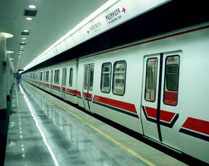 Sources from the State Planning Commission tell an appropriation of 800 billion yuan is to be made for developing China's urban traffic during the 10th Five-year Plan years 2001-05, of which urban track is to take 200 billion (US$24.19 billion). A 450km-long urban track as assured is to be built according to Construction Ministry's Railway and Light Rail Research Center.
Sources from the State Planning Commission tell an appropriation of 800 billion yuan is to be made for developing China's urban traffic during the 10th Five-year Plan years 2001-05, of which urban track is to take 200 billion (US$24.19 billion). A 450km-long urban track as assured is to be built according to Construction Ministry's Railway and Light Rail Research Center.
It is learned that track projects and like undertakings planned to that end have already been underway in 20 super-large and ultra-large Chinese cities out of 34 with a population over one million. Of these Beijing, Shanghai and Guangzhou are most noted bending on construction of track transportation lines of their own. Operating in Beijing underground so far there are 54 km of subways as No.1, Ring Line and Fuchengmen-Bawanfeng line along with Line No.5 over a distance of 27.7 km with construction launched in July.
Shanghai has had three metro lines launched. Meanwhile, 10 new track lines as for magnetic suspension transport and light rail to a length of 200 km will be built in the municipality as expected by the end of the 10th Five-year Plan years.
Guangzhou claims an 18.48 km metro as Line No.1 built and put into operation as early back in June 1996. Being presently built by the city is also Line No.2, a line 23 km long, 6 stations having been built, going to be put into operation by 2003. Line No.3, Line No.4 and Line No.5 are under planning. An underground track transportation network adding up to a length of 130 km as expected will be built and put into operation by 2010.
Shenzhen and Nanjing have also taken up their metro construction. Plans are also being mapped for building metros in Xi'an, Chengdu, Dalian. Qingdao, Zhengzhou, Tianjin, Changchun, Chongqing, Wuhan and Harbin.
When you should take a comprehensive look into the development of metro transportation in various countries throughout the world, you would find that when a country comes with a GDP avenue up to a per-capita average of over US$500 there comes time for metro transportation lines to be developed. From a per-capita GDP average of US$500-2000 subways will have to be built on a considerable scale. With a per-capita GDP average of over US$2000, subways must be launched on a much developed level.
According to China's Statistics Yearbook, in 1996, of 209 prefecture-level cities 172 already claimed a per-capita GDP average of US$1000 and 56 had a GDP per-capita average of over US$2000. Placed atop was a per-capita GDP average of US$9823 by Shenzhen. As things are now in China, there has come a time in building up the country's urban track fast centering metro construction.
(People’s Daily August 9, 2002)
|

